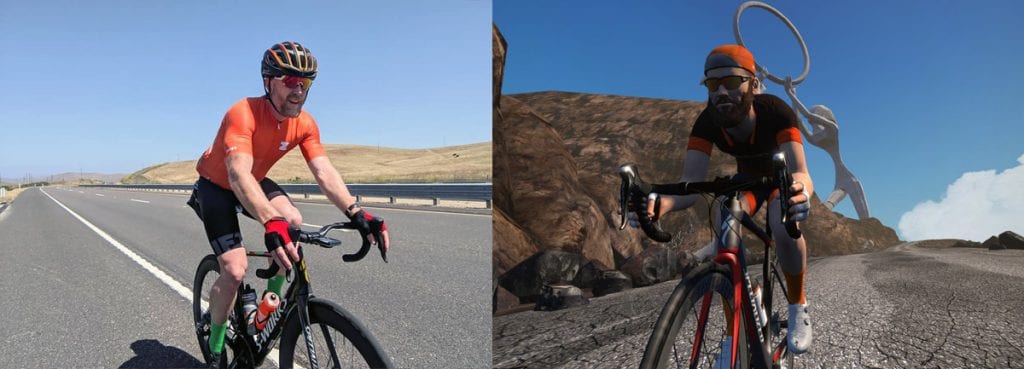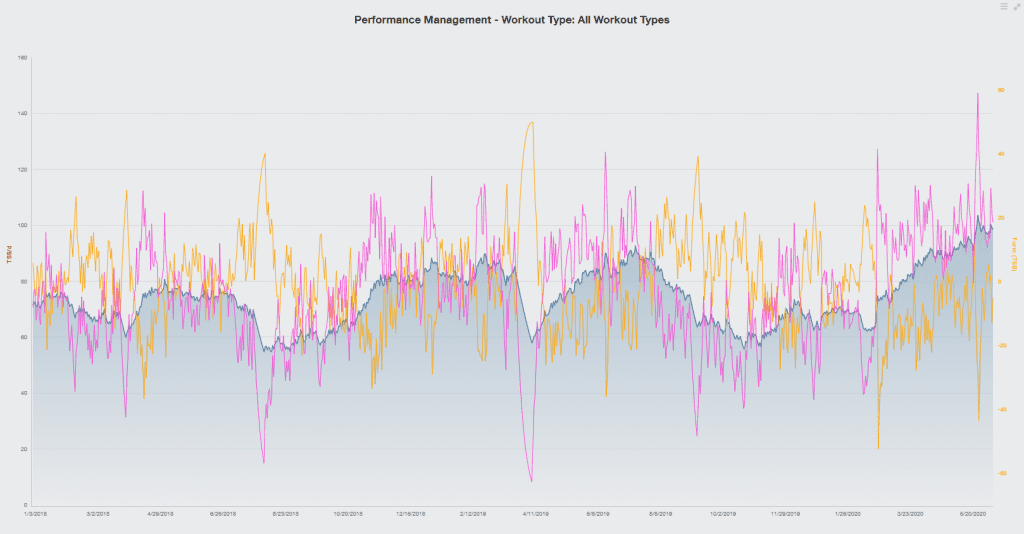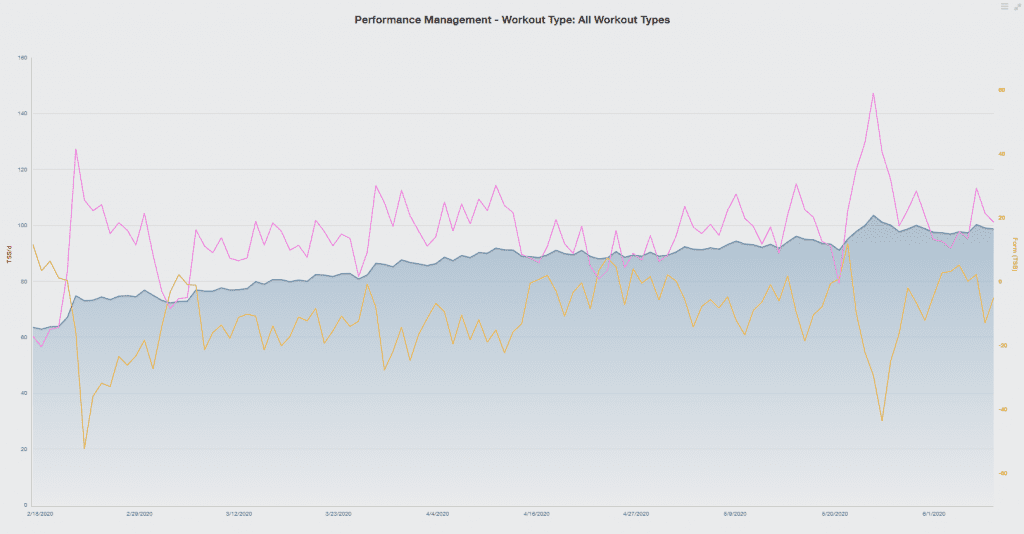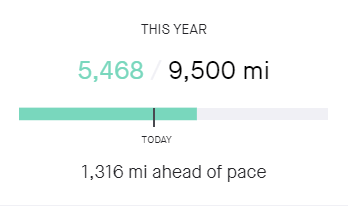Some people ride to relieve stress – and we’ve all had plenty of that this year. Others do it to lose weight. And still others are following specific training plans, even though their racing goals this season are murky at best.
Me? I ride because I love the results. Cycling brings me much-needed fitness, healthy competition, and fun with friends. It also lets me see my surroundings in a fresh light: there’s simply no better way to experience the world.
This Year vs Last
It’s been a strange year, hasn’t it? Here we are in early June, and I’m still spending ~80% of my riding time on Zwift. This isn’t normal. In past years I would be riding ~80% of my miles outside by now. But shelter-in-place (SiP) combined with a shrinking set of local riding buddies and so many fun Zwift events has resulted in this odd situation.
It’s also resulted in me being fitter than ever before.

Tracking Fitness
How do you track fitness? There are, of course, a variety of ways to do so. Tracking methods are largely driven by which sport(s) and goals you’ve chosen. Swimmers and cyclists have different fitness metrics. Racers look at different numbers than the casual athlete seeking to shed 20 pounds.
The important thing is to find metrics that work for you. Here are the numbers I keep a close eye on:
- My fitness score in TrainingPeaks
- My FTP
- My weight
- My body fat percentage
None of these is a perfect measure of cycling fitness. But they are easy to track and combined give me a solid picture of where I’m at. And you know what? I’m in a really good place right now.
My FTP is as high as its ever been – somewhere in the 305-315 watts range, depending on how I test it. My weight has been down around 180 pounds (~82kg) for the last two months, which is the longest I’ve ever stayed so light. And my body fat percentage and watts per kilo numbers are happily reflecting this combination of low weight and high strength!
What I’m really excited about, though, is my fitness score in TrainingPeaks.
How TrainingPeaks “Fitness” Works
TrainingPeaks uses a metric called TSS to assign a Training Stress Score to each workout. TSS is based on the duration and intensity of your workout so for example, a full-gas 1-hour effort may have the same TSS as a 3-hour ride at social pace.
That TSS metric is then used to chart your daily level of fatigue, fitness, and freshness:
- Fatigue: how tired is your body from recent training? This is an exponentially weighted average of your past 7 days worth of TSS.
- Fitness: how strong is your body, thanks to all the recent training? This is an exponentially weighted average of your past 42 days worth of TSS.
- Form: how good will you feel on today’s ride? Subtract yesterday’s fatigue from yesterday’s fitness and you have today’s form.
The TrainingPeaks app combines these metrics into a Performance Management Chart (PMC). The PMC can be used to easily see how your overall fitness is changing, as well as where you stand in terms of form.
My Current Fitness
Here is my PMC from January 2018 to present:

As you can see, I’m currently in the high 90’s, and even hit a high of 104 a couple weeks ago! My previous annual highs were 93 (July 2019) and 81 (May 2018).
(That high of 104, and the big pink fatigue spike you see in the chart from a couple weeks ago, is the result of a 4-day, 426-mile IRL bike trip my brother and I took down California’s Pacific Coast Highway. A rather spur of the moment adventure which I didn’t train for at all! More on those epic rides in another post.)
My Week
So how did I arrive at the best shape of my life? Am I sticking religiously to a perfectly-structured training plan?
Well, that’s the crazy part. I’m not! I’ve certainly done structured training before – for months at a time. And I can vouch for its effectiveness. The problem for me is, I don’t enjoy it. And it’s important for me to look forward to riding my bike.
So instead, what I’ve done since late February 2020 is essentially this:
- Monday: medium length, medium-easy pace. This means mostly Zone 2 HR over 90-120 minutes.
- Tuesday: race day. Races vary from 20-75 minutes in length, and my overall ride time with warmup and the actual race will be 90-120 minutes.
- Wednesday: easy day. 60-90 minutes, Zone 1-2 HR.
- Thursday: race day. Races vary from 20-75 minutes in length, and my overall ride time with warmup and the race will be 90-120 minutes.
- Friday: lead my Sprintapalooza ride, then hang out for another 30 minutes or so, not pushing hard. 75-90 minutes.
- Saturday: long and hard. I’ll cobble together group rides and races into a session 2.5-3 hours long, sometimes more. This usually looks like a long warmup followed by a longish race (75 minutes or more), then additional steady riding to build endurance by putting more fatigue into the already-tired race legs.
- Sunday: easy day. Usually 60-90 minutes of easy riding, often outdoors on the MTB up a local climb, just enjoying the scenery.
Every week is a bit different, and every 5 weeks or so I take a rest week where I avoid sustained hard efforts and let my body rest and rebuild. But overall, I’ve basically stayed within this framework for the past few months. And almost all of my riding has been in Zwift events: group rides for easier days, races for race days.
This has led to steady progress in my fitness numbers. Here’s a chart from mid-February 2020 to present:

Indoor vs Outdoor Efficiency
I typically ride 12-14 hours total each week. Could my training be made more efficient? Absolutely. Following a structured training plan would let me reduce the hours put in, for the same training benefit.
But would I enjoy it? Nope.
So regardless of whether I ride outdoors or indoors, I won’t be doing a structured training plan. And here’s what I know is true for me: I consistently pack more solid training into an hour on Zwift than I do outside.
Outside ride time includes getting to the place where I can begin my workout. It also includes stoplights, traffic, weather, and all those fun outdoor niggles. Taking TSS as an objective metric, I would estimate that my TSS per hour is reduced by 10-20% when I ride outside, compared to when I ride on Zwift. That means if I moved all my training time outdoors, my fitness score would eventually drop by 10-20%.
That’s what has happened in past years. But not this year.
A decrease of 10-20% seems crazy. But it makes sense. And it explains the true stories of pros like Mathew Hayman who recuperated on Zwift then returned and won Paris-Roubaix. Or the more recent example of Ashleigh Moolman-Pasio, who spent several solid weeks under SiP “house arrest” on Zwift in Spain only to destroy her Rocacorba PR the moment she was allowed to get outside again.
Bottom line: riding on Zwift lets you pack a lot of TSS into your training time. And I’ve been doing a lot of riding on Zwift.
TSS Caveat
I’ll mention this now, before someone does it in the comments: coaches and experienced cyclists will say that there’s more to fitness than TSS. And they’re correct: a high fitness number doesn’t tell me how well-trained I am for a particular race.
As an example: I could rack up a lot of TSS doing long, slow rides, but if my races require high sprint power, I’m not building the fitness needed to meet my goals.
But here’s the thing: I’m not training with my eye on one or two big events. The competition I enjoy happens every week, and it’s a part of my training! I’m riding Zwift races to train for Zwift races. And if our local cycling group ever gets revved up again, I’ll ride our Tuesday night hammerfest to train for next week’s Tuesday night hammerfest.
So the TSS I’m racking up is targeted quite nicely at the sort of intervals I want to train for, because that TSS is earned in those actual events, week after week!

Mileage
Distance really isn’t a great fitness metric, but it’s a fun one. So every year I set a distance goal in Strava. This year I was lazy, and simply set the same goal as last year: 9,500 miles. But thanks to all the indoor riding, I’m on pace to break 11,000 miles for the year – much more than I’ve ever done before.
What About You?
2020 has been a crazy year. But thanks to good health, SiP, and a keen fondness for Zwift cycling, I’ve been able to ride into the best shape of my life.
What about you? I’d love to hear what has this crazy year done to your fitness? Share below!

